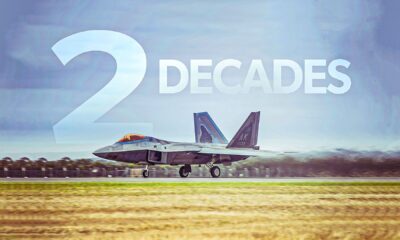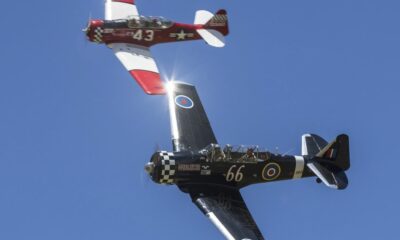World
Unveiling America’s Top 5 Fastest Fighter Jets for 2025

Speed has long been a pivotal factor in the design of fighter aircraft, but contemporary American jets have evolved to integrate speed with stealth, advanced sensors, and multirole capabilities. As of 2025, the fastest jets in active service with the United States military showcase a balance of performance and versatility, with the F-15 Eagle leading the pack. This aircraft, alongside its variants—the F-15E Strike Eagle and the new F-15EX Eagle II—achieves a remarkable top speed of Mach 2.5 while carrying significant weaponry.
The Lockheed Martin F-22 Raptor closely follows, offering not only Mach 2 capabilities but also supercruise and stealth features, solidifying its role as the Air Force’s premier air dominance platform. Next in line is the F-16 Fighting Falcon, recognized for its agility and efficiency, reaching Mach 2 while remaining the most widely produced Western fighter. The naval counterpart, the F/A-18E/F Super Hornet, sacrifices a bit of speed for enhanced durability and versatility, serving as the backbone of U.S. carrier air wings. Finally, the F-35 Lightning II, with a top speed of Mach 1.6, redefines fighter performance through its stealth and advanced sensor fusion capabilities.
F-15 Eagle and F-15EX Eagle II: Legends of Speed
The McDonnell Douglas F-15 Eagle has long been celebrated for its exceptional speed and performance. Originally designed in the late 1960s, the aircraft features powerful twin engines, large wings, and advanced radar systems, which together provide a high thrust-to-weight ratio. The introduction of the F-15EX Eagle II marks a significant upgrade, incorporating advanced technology while preserving the performance characteristics that have made the Eagle iconic.
With a typical range of 2,400 miles (3,840 km) and a production total exceeding 1,500 aircraft, the F-15 remains a formidable force. The F-15EX, developed by Boeing, integrates digital fly-by-wire controls and an AN/APG-82 AESA radar, enhancing its capabilities for air defense and strike missions. The United States Air Force plans to procure over 100 F-15EX units, ensuring this jet’s relevance through the mid-2020s and beyond.
F-22 Raptor: The Pinnacle of Air Superiority
The Lockheed Martin F-22 Raptor stands out as the U.S. Air Force’s first operational fifth-generation fighter aircraft. With a top speed of Mach 2, it combines stealth, supercruise, and exceptional agility. Introduced in 2005, the F-22 features advanced internal weapons bays and a highly integrated glass cockpit that provides pilots with a comprehensive tactical picture.
Although the production of the F-22 ceased in 2011 with a total of 195 units built, the aircraft continues to be a critical asset in various missions, including air policing and precision strikes. Upgrades to its sensors and weapons systems are ongoing, ensuring the F-22 remains competitive against emerging threats.
F-16 Fighting Falcon: A Versatile Workhorse
The General Dynamics F-16 Fighting Falcon has evolved into one of the most successful fighter aircraft globally, with over 4,600 units produced. Originally introduced in the 1970s, the F-16 was designed as a lightweight complement to the F-15, featuring innovations such as a blended-wing body and side-stick controller.
Today, the F-16 serves in numerous roles, including air superiority, ground attack, and reconnaissance. The aircraft’s typical range of 2,002 miles (3,220 km) and adaptability have solidified its position in the air forces of many allied nations. The latest F-16V and Block 70 variants incorporate advanced AESA radar, keeping this fighter relevant in modern combat scenarios.
F/A-18E/F Super Hornet: Strength on the Seas
The McDonnell Douglas F/A-18E/F Super Hornet plays a crucial role in the United States Navy’s carrier-based operations. With a top speed of Mach 1.8, the Super Hornet combines air-to-air and air-to-ground capabilities, making it one of the most adaptable fighter jets in history.
Originally entering service in the 1980s as the F/A-18A, the Super Hornet has undergone extensive upgrades, including digital fly-by-wire controls and modern sensors. With a typical range of 1,275 miles (1,458 km) and over 632 units produced, it continues to be a mainstay of U.S. naval aviation, supported by ongoing Block III upgrades for enhanced capabilities.
F-35 Lightning II: The Future of Air Power
The Lockheed Martin F-35 Lightning II is noteworthy as the first operational stealth multirole fighter designed to replace a range of legacy aircraft across the U.S. military. Available in three variants, including the F-35A, F-35B, and F-35C, the F-35 features advanced electronic warfare systems and a highly integrated sensor suite.
Despite its top speed of Mach 1.6, the F-35’s true strength lies in its ability to perform intelligence, surveillance, and reconnaissance missions while sharing data with allied forces. With production exceeding 1,255 units, its ongoing Block 4 upgrades are expanding its capabilities, reaffirming its position as a cornerstone of Western tactical air power.
These five fighter jets exemplify the evolution of aircraft design from a focus on speed to a comprehensive approach that includes stealth, advanced technology, and multirole capabilities. As the landscape of air combat continues to shift, these aircraft represent the forefront of American military aviation.
-

 Politics3 weeks ago
Politics3 weeks agoSecwepemc First Nation Seeks Aboriginal Title Over Kamloops Area
-

 World4 months ago
World4 months agoScientists Unearth Ancient Antarctic Ice to Unlock Climate Secrets
-

 Entertainment5 months ago
Entertainment5 months agoTrump and McCormick to Announce $70 Billion Energy Investments
-

 Lifestyle4 months ago
Lifestyle4 months agoTransLink Launches Food Truck Program to Boost Revenue in Vancouver
-

 Science5 months ago
Science5 months agoFour Astronauts Return to Earth After International Space Station Mission
-

 Technology3 months ago
Technology3 months agoApple Notes Enhances Functionality with Markdown Support in macOS 26
-

 Top Stories2 months ago
Top Stories2 months agoUrgent Update: Fatal Crash on Highway 99 Claims Life of Pitt Meadows Man
-

 Lifestyle3 months ago
Lifestyle3 months agoManitoba’s Burger Champion Shines Again Amid Dining Innovations
-

 Sports5 months ago
Sports5 months agoSearch Underway for Missing Hunter Amid Hokkaido Bear Emergency
-

 Politics4 months ago
Politics4 months agoUkrainian Tennis Star Elina Svitolina Faces Death Threats Online
-

 Politics4 months ago
Politics4 months agoCarney Engages First Nations Leaders at Development Law Summit
-

 Technology5 months ago
Technology5 months agoFrosthaven Launches Early Access on July 31, 2025





















